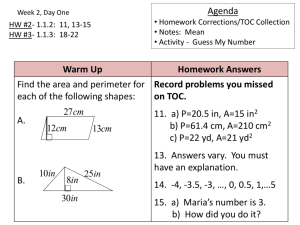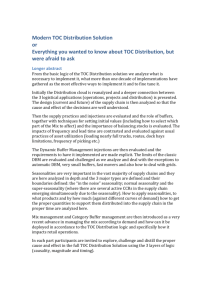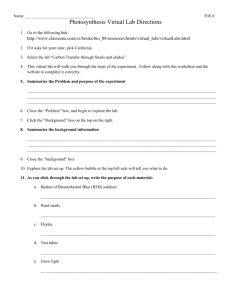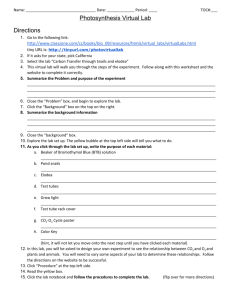Warriors-Conquistadors-Freedom Fighters
advertisement
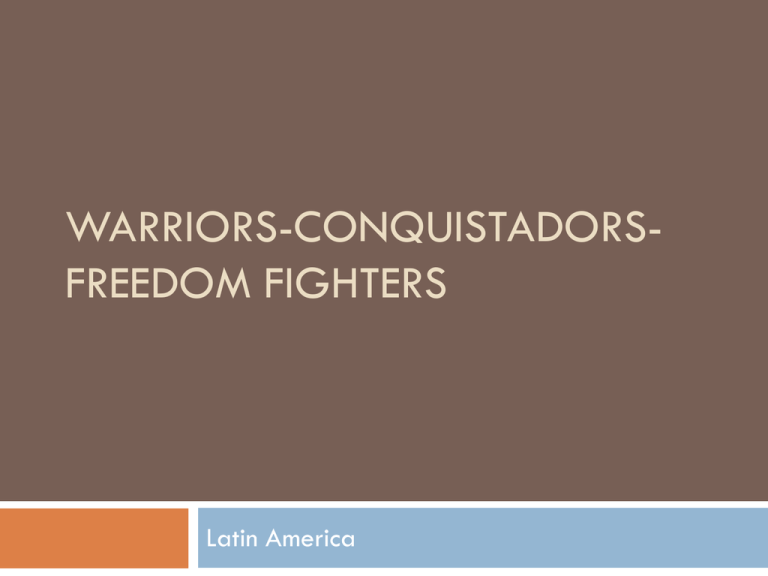
WARRIORS-CONQUISTADORSFREEDOM FIGHTERS Latin America Table of Contents Aztecs Cortes Montezuma L’Ouverture Incas Bolivar Pizarro Hidalgo Atahualpa Language and Religion Freedom Fighters Columbian Exchange Slavery Revolution Cuban Revolution Zapatistas Aztec Review Most powerful in central and southern Mexico at the time of European exploration. Capital-Tenochtitlan. Modern day Mexico City. Good farmers, paid large taxes, calendars, mathematics Conquered by the Spanish and Cortes in 1521. BrainPop-Click here to learn about the Aztecs and Montezuma Back to ToC Hernan Cortes—Conquistador Born in 1485 in Spain • At 19, he sailed to the Americas to live and learn how colonies were run. He became mayor of a Cuban town. • In 1518, he was told to go to Mexico to defeat the Aztecs. Upon getting there, other native groups joined them. • He was welcomed by the Aztec Leader, Montezuma II, so Aztec defeat started easier than they had planned. • BrainPop—Conquistadors—Click here to learn about Cortes and Pizarro Montezuma II—Aztec Ruler Aztec ruler from 1500 to 1520. Expanded the empire—forced conquered tribes to pay the empire high taxes and give their people for sacrifices. He thought Cortez was a god-like being and welcomed him with gifts and gold. Cortez took him hostage and ruled his empire. In 1520, the Spanish and Aztecs fought and Montezuma was killed. Back to ToC Inca Review Began in the early 1400’s. Stretched over 2000 miles in western South America. Known for wealth, textiles, roads, farming, mathematics and accounting. Spanish wiped out much of the culture, but the language, farming techniques, and textile making remain a part of the local culture. BrainPop-Click for the Incas Back to ToC Francisco Pizarro Born in Spain in 1475. Pig farmer as a boy. In 1502 went to Hispanola and learned about exploring and conquering. In 1523, he let a voyage to the west coast of South America, just south of Panama. Back to ToC Francisco Pizarro He was told by Indian traders that there was a very rich country to the south. In 1531, he became viceroy of the lands and took 3 ships, 200 men, and 3 dozen horses to conquer the Inca. Back to ToC Atahualpa—The Last Sapa Inca Fought with his brother about who would control the empire. Thought to be a descendant of the sun god. Atahualpa was tricked by the Spanish under Pizarro in 1532, and this event made for the last of the Inca empire. Back to ToC The Last Encounter with the Inca A meeting was arranged between Pizarro and Atahualpa. When Atahualpa approached, the Spanish attacked. Pizarro captured Atahualpa and demanded ransom. He was executed in 1533 by Pizarro. This was the end of the empire. Back to ToC Spanish Settlements Pizarro became wealthy and powerful. He founded Lima, Peru and built a palace. Other Spanish were jealous of his wealth. In 1541, Pizarro was killed in an attack on his palace. For the next 300 years, the Spanish continued to rule the land. Back to ToC The Columbian Exchange Back to ToC The Columbian Exchange What is it? The exchange of animals, plants, people, and diseases from the Old World to the New World. How did it affect Latin America? The goods brought from Europe changed farming— plantations and slave labor were started. The indigenous population was defeated because of disease. Horses allowed further and faster travel and ideas and goods spread. Back to ToC Slavery in Latin America Because of the Columbian Exchange, Europeans in America needed cheap labor. Labor for mining the metals. Labor for farming the plantations. Why weren’t the native people the slaves? The natives were dying from disease, violence with the Europeans, harsh conditions. Many retreated to the mountains and jungles. Back to ToC Slavery in Latin America Brought from Africa by ship. Most brought to the tropical areas of Latin America where plantations were large. Conditions were very similar to the conditions that slaves in North America endured. For 300 years slavery grew. As different countries gained freedom in the 1800’s, slavery ended. Back to ToC Descendants of Slaves Many of the descendants of African slaves are part of the culture today. A person with both African and European background. People with only African ancestors and people with African and European ancestors make up a large part of the population in the tropics. Cuba-60%, Brazil-50% Mestizos-A person with mixed Spanish and Native American background. Back to ToC Influence on Language and Religion As the Spanish and Portuguese conquered Latin America, they spread their language and religion. Spanish Most of Central America Most of South America Caribbean Islands Portuguese Brazil-because it is so large, almost as many people in Latin America speak Portuguese as Spanish. Back to ToC Influence on Language and Religion Important to note that these were the official languages for government, business and power. However, many indigenous people still speak their native languages. Others blended their native languages with European languages. For example, Haitians speak Haitian Creole-a blend of French and native African languages. Back to ToC Influence on Language and Religion When the conquistadors and settlers came to Latin America, they sent priests, friars, and monks to set up missions. Some native groups were forced to say they were Christian, others mixed Christianity and their traditional beliefs. Back to ToC A Desire for Freedom The governments of Spain and Portugal ruled most of Latin America for nearly 300 years. At times the people being ruled by the Europeans got restless. The American Revolution in 1776 gave some in Latin American the idea that they too could be free. In 1789, the French Revolution showed that the kings of Europe could be beaten. These events encouraged Latin Americans in the belief that they might be able to overcome their European rulers. Back to ToC Toussaint L’Ouverture Born a slave in the mid-1700’s. Father had been a free African who was captured and sold into slavery. In 1789 the French Revolution occurred and the new French government granted freedom to slaves and in Haiti, they were mad and took back the freedom. Toussaint was furious and led a slave army to defeat the French troops. Back to ToC Toussaint L’Ouverture 1793-He led his men against British and Spanish troops. He became in charge of Saint Domingue (Haiti) even though it was a French colony. 1802-Napolean, the French emperor, sent troops to regain control. Toussaint was captured and sent to France where he died. By 1804, Haiti gained independence. Back to ToC Simon Bolivar (“The Liberator”) History of Bolivar Gained Independence for: Bolivia Colombia Ecuador Panama Peru Venezuela Back to ToC Miguel Hidalgo Known as the father of Mexican independence. Born in 1753. Had a good education. Worked among the peasants Back to ToC Miguel Hidalgo In 1808 France invaded Spain and the king was removed. 3 options: New French government Old Spanish government New Independent government In 1810, the French government turned on him, and he started the independence movement. He was captured and killed in 1811, and in 1821, Mexico gained independence. Back to ToC

